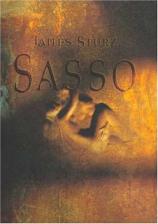Sasso
Review
Sasso
It's funny how things work out. The guy who was class president in
college gets arrested for indecent exposure. The star high school
quarterback takes a wrong turn between the field and the locker
room and winds up strung out on the street. The weird character you
knew who had nothing but a five dollar bill and a dirty shirt and
never wanted to change either one winds up working in the creative
department of a production company and an incidental
multimillionaire. And the girl you barely noticed in school, who
wouldn't say dirt if she had a mouthful, shows up on television as
part of an astronaut team.
There are books like that. There are the books that hit and are
immensely popular and stay that way for decades and even for
generations. Then there are some books that come and go like
comets. They pass through the public's headlights, fly high and
bright, and then they're gone --- and often forgotten. My closet
favorites, though, are the books that are published to little
fanfare, acquire a small but loyal following by word of mouth and
endure year after year, quietly adding to their legion of readers.
I'm thinking of BEEN DOWN SO LONG IT LOOKS LIKE UP TO ME by Richard
Farina, THE PAINTED BIRD by Jerzy Kosinski, books like that. And
while we've got that list out, let's add SASSO by James Sturz to
it.
SASSO is ostensibly a mystery, and on that level alone, it's a good
one. It's related from the point of view of an anonymous American
archeologist, who is describing events in letters to his pregnant
girlfriend in New York City. The narrator and his three colleagues
are in southern Italy, in a small town named Mancanzano; they are
brought in to investigate after a pair of teenagers are found dead
in a series of caves just outside the village. The caves, known as
The Sassi, soon yield four more bodies.
There is a sexual element to the murders, and the sensational
aspect of the crimes is heightened by the murder of several local
dogs whose bodies are found around town and in the caves. The work
of the team is interrupted and brought practically to a standstill
by the local police force, whose detection skills are on a level
such that they would be hard pressed to track a train. The humor
that results in their ineptitude is nicely counterbalanced by the
degree and extent of their corruption; one grimy hand washes, and
taints, the other. The archeological team, meanwhile, finds itself
being slowly sucked into the quiet but obvious carnal atmosphere of
the village. The narrator himself undertakes a potentially lethal
affair with Felippa, an (almost) irresistible 19-year-old who wants
his child. When he discovers Felippa's connection with the crime,
it serves as both an attraction and repulsion, with the potential
to destroy him.
If Sturz merely wanted to write a fine murder mystery, SASSO would
be a fine accomplishment. But it's much more than that. There are
huge chunks of anecdotal history of the region woven through SASSO,
and they are not sugarcoated. Booker T. Washington, after visiting
southern Italy, equated the lot of the rural peasants there with
those of southern black sharecroppers. Sturz captures the poverty
and misery of the region with a practiced, unblinking eye, yet
counterbalances it with a sardonic, ironic humor that permeates the
novel from first page to last. It is not unusual while reading
SASSO to be saddened, horrified and amused, often within the same
paragraph and occasionally within the same sentence.
SASSO is Sturz's first novel. I don't know if he has any more
percolating within, but even if he does not, this book will cement
his notoriety. This is a novel whose reputation will build slowly,
surely and, ultimately, indelibly.
Reviewed by Joe Hartlaub on January 23, 2011



